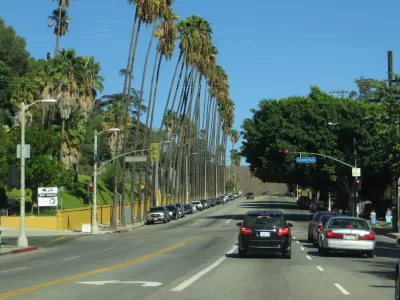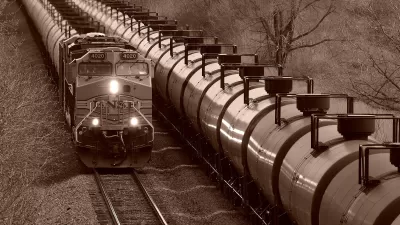The Green New Deal is far from the law of the land, but if this nation were to adopt the legislative agenda proposed by congressional Democrats, it would (and should) have major implications for planning practice.

[Updated February 12, 2019.]
As reported late last week by Planetizen correspondent Irvin Dawid, Sen. Edward J. Markey (D-Mass.) and Rep. Alexandria Ocasio-Cortez (D-N.Y.) introduced a nonbinding House resolution that has become commonly known as the Green New Deal, calling for the country to transition to carbon neutrality by 2030.
Since that release, and in the weeks leading up to the documents full reveal, commentators have been lining up to offer their take on the Green New Deal. Some of that analysis has focused on matters related to the work of planners.
Taking the Train to Green
Umair Irfan writes for Vox on the Green New Deal's focus on train travel—an agenda quickly ridiculed by Conservative commentators, but embraced by Irfain.
"For a big, ambitious plan to fight climate change, it would make perfect sense to target transit in general and air travel in particular," writes Irfain. Trains are already competing with airlines in many parts of the country and many more parts of the world, notes Irfain, and shifting from air travel to trains would drastically reduce carbon emissions from the transportation sector.
Land Use Missing in Action
A few weeks before the Green New Deal made it to the House floor, Jenny Schuetz provided analysis of the earliest outlines of the Green New Deal, focusing specifically on the land use measures included in the proposed agenda.
As noted by Schuetz, however, the Green New Deal does no address land use, despite "decades of poor urban land use decisions" being "a major underlying cause of environmental harm."
"Specifically, better urban land use would reduce greenhouse gas emissions (GHGs) from cars and limit the human and financial costs caused by developing environmentally risky land," writes Schuetz.
To better integrate land use planning and development into the Green New Deal, Schuetz recommends three broad policy goals: 1) improving the balance of jobs, housing, and services to reduce driving; 2) reducing development on environmentally risky land; and 3) improving governance and land use approval processes.
A 'Huge Flaw'
Finally, an article by Alex Baca exposes that lack of focus on issues of land use and development as the "huge flaw" of the Green New Deal. Here's Baca's strongly worded premise:
But the Green New Deal has a big blind spot: It doesn’t address the places Americans live. And our physical geography—where we sleep, work, shop, worship, and send our kids to play, and how we move between those places—is more foundational to a green, fair future than just about anything else. The proposal encapsulates the liberal delusion on climate change: that technology and spending can spare us the hard work of reform.
To make that point, Baca analyzes digs into the environmental and economic costs of sprawl, directly countering arguments that electric vehicles can save the planet from climate change if humans continue to sprawl across the planet.
Update: The Suburbs
After Planetizen published this summary of Green New Deal-related articles, Amanda Kolson Hurley added another entry to the record, this time about the potential of the Green New Deal to retrofit the suburbs. To do so, writes Hurley, the New Green Deal should look to the Old Deal, and the greenbelt-towns program, undertaken by the federal Resettlement Administration (RA) in Maryland, Ohio, and Wisconsin.
FULL STORY: The Green New Deal’s Huge Flaw

Alabama: Trump Terminates Settlements for Black Communities Harmed By Raw Sewage
Trump deemed the landmark civil rights agreement “illegal DEI and environmental justice policy.”

Study: Maui’s Plan to Convert Vacation Rentals to Long-Term Housing Could Cause Nearly $1 Billion Economic Loss
The plan would reduce visitor accommodation by 25% resulting in 1,900 jobs lost.

Why Should We Subsidize Public Transportation?
Many public transit agencies face financial stress due to rising costs, declining fare revenue, and declining subsidies. Transit advocates must provide a strong business case for increasing public transit funding.

Wind Energy on the Rise Despite Federal Policy Reversal
The Trump administration is revoking federal support for renewable energy, but demand for new projects continues unabated.

Passengers Flock to Caltrain After Electrification
The new electric trains are running faster and more reliably, leading to strong ridership growth on the Bay Area rail system.

Texas Churches Rally Behind ‘Yes in God’s Back Yard’ Legislation
Religious leaders want the state to reduce zoning regulations to streamline leasing church-owned land to housing developers.
Urban Design for Planners 1: Software Tools
This six-course series explores essential urban design concepts using open source software and equips planners with the tools they need to participate fully in the urban design process.
Planning for Universal Design
Learn the tools for implementing Universal Design in planning regulations.
Caltrans
Smith Gee Studio
Institute for Housing and Urban Development Studies (IHS)
City of Grandview
Harvard GSD Executive Education
Toledo-Lucas County Plan Commissions
Salt Lake City
NYU Wagner Graduate School of Public Service





























